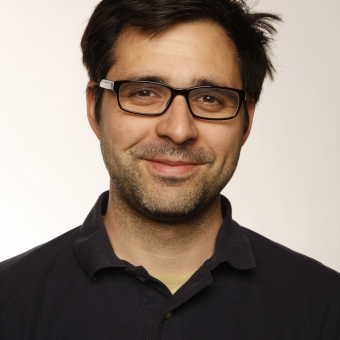Leveraging Lean UX to Lead Successful Agile Design Teams
Jeff Gothelf · Monday, November 12 · 8:30 am – 5:30 pm · in Plaza B
Bring user-centricity back to the scrum process. Use product discovery practices to build a stronger collaboration with product development teams. Challenge current ways of working to improve the integration of UX and Design in the Agile process.
Develop management strategies to ensure UX is present in every product conversation. Ensure cross-functional collaboration is present at the leadership level.
Jeff Gothelf is the author of Lean UX, Sense & Respond and Lean vs Agile vs Design thinking. He lives and works as an independent consultant based in Barcelona.
The Day’s Agenda
Morning
Make the shift to an integrated Lean UX practice
- Move beyond process recipes: this is bigger than just lean, Agile, lean startup, and lean UX, and design thinking.
- Learn how to build continuous feedback loops into the entire product design and development process.
- Achieve better designs by prioritizing business and user outcomes, not features or services.
Start with assumptions and hypotheses for your products
- Write and solve business problems framed consistently for every discipline.
- Prioritize the best product ideas based on customer success.
- Design experiments, collect data and decide whether to kill, pivot, or persevere as a whole team.
Afternoon
Identify the challenges to implementing Lean UX
- Learn to regularly retrospect on process challenges.
- Identify consistent themes with affinity mapping.
- Prioritize the biggest current challenges based on how they affect team behavior.
Apply the process to your process
- Declare assumptions about why integrating UX and Agile is challenging.
- Learn how to use Objectives and Key Results (OKRs) to measure success in terms of team and company behavior.
- Design experiments to see which techniques improve the way you work.
You’ll work smarter, not harder
Bring design and development together in an agile way
The old waterfall approach (and its scrum-friendly variants) to design and development is dead. The new way is a collaborative, continuous cycle of concepting, delivering, learning, and iterating.
Integrate a user-centric perspective into the process
Reframe the work discussions from outputs to objective business and user outcomes. Bring data about your customers and your business into the decision making process. Then, apply this approach to the way you work.
Ensure UX is present in all part of the process
Develop a shared language and increase productivity with colleagues by employing the tactics of business problem statements, assumptions, OKRs, hypotheses, and experiment design.
You’ll see how to:
- Implement OKRs successfully and use this goal-setting technique to ensure Lean UX happens in every initiative.
- Encourage cross-functional collaboration based on real data.
- Structure experiments to test your hypotheses and continuously iterate.
- Implement Lean UX in a way your development and leadership teams can buy into.
- Use the ideas of continuous learning and iteration to change how you lead your design teams.
- Use behavior–not just for customers but for your team too–to determine how well the process is working and what needs to change.
Lead the adoption of customer-centered practices in your company’s Agile process
Focus relentlessly on outcomes
Collaborate on building a customer-centric backlog of features by forming assumptions and testing hypotheses.
Learn how to prioritize what to work on
By focusing on the most important business outcomes and user goals, product teams ensure they are working on the right opportunities to improve the product.
Use the lean process to lead improvements to the way you work
By involving the entire team–product management, engineering/IT, and UX–in reframing the conversation to focus on the goals your team is trying to achieve both in product and ways of working you ensure a human-centric approach.
Drive the adoption and integration of a more transparent, energizing design process
Spend hands-on time working with teams who want to solve the same problems.
Form assumptions and hypotheses to deliver great products
During the first half of the day, you’ll work individually and in small groups to understand how Lean UX should work by defining work as a problem statement to solve, declaring assumptions, writing Objectives and Key Results (OKRs), forming hypotheses, creating proto-personas, brainstorming opportunities, and designing experiments using “the two key questions” method.
In the afternoon, you’ll use these same techniques to identify your current challenges implementing and leading a Lean UX practice in your organization and define ways to improve them along with clear, human-centric measures of success (OKRs).
Jeff Gothelf

Jeff Gothelf once spent six months on the road with a circus and several more years as a touring musician. Really, if he doesn’t show you the pictures during his workshop or talk, ask him about it. You won’t be sorry.
But these days, Jeff is the ringmaster of lean UX, a methodology to reduce risk and minimize waste in product development. Jeff is the co-author of the excellent books, Lean UX and Sense & Respond as well as the short, but impactful Lean vs Agile vs Design Thinking (published on Sense & Respond Press, a company Jeff co-founded in 2017). He runs his independent consulting and coaching practice out of Barcelona.
So suffice it to say, Jeff is The Guy behind lean UX, and we couldn’t be more excited to have him here to teach you what he knows.
And part of what he knows came from his experiences as co-founder at Neo Innovation, and UX director at TheLadders.com. He also spent time in interaction design and UX roles for Fidelity, Publicis Modem, WebTrends, and AOL.
So ladies and gentlemen, boys and girls: come on into the big tent for this ace workshop.

